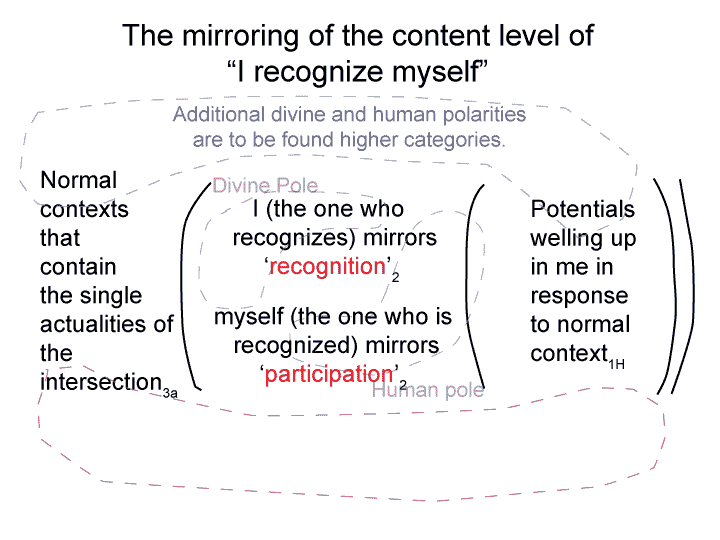Monthly Archives: March 2016
Man and Sin by Piet Schoonenberg (1964) 2.1EF
Summary of text [comment] page 69
[The intersection of participation and recognition contains a polarity between divine normal contexts (the sources of grace, as well as self destruction) and human potentials (the subject of grace, as well as self destruction).
This polarity encounters the polarity of exclusive normal contexts that bring either grace or self destruction into relation with the monadic sea of possibility.
Thus, I present an image of the word ‘counter’ in the (translator’s chosen term from the original Dutch) ‘counterpoles’ describing the difference between the source and the subject of grace.
Finally, I compare this intersection to the ground of the dyadic actuality of ‘the human in the image of ‘the One Who Recognizes’ and ‘the One Who Is Recognized’‘. This comparison appears in the next blog.]
Man and Sin by Piet Schoonenberg (1964) 2.1EE
Summary of text [comment] page 69
[At this point, I have a deeper appreciation of the qualifier ‘counter’ in Schoonenberg’s term ‘counterpole’.]
Schoonenberg uses the term to describe the difference between the source and the subject of grace.
[What have I seen with these models?
A fundamental polarity lies within the intersection containing the single actualities of the states of grace or self-destruction. Additional polarities are found in the content-level nested form incorporating this single actuality.
This is shown in blog 2.1 DY.]
Man and Sin by Piet Schoonenberg (1964) 2.1ED-2
[‘Participation’ points to the triadic structure of the divine manifested in the human.
Our human nature is to participate in the divine nature.
How do we do that?
We image God by creating relationships, artifacts and potentials. We create in all three realms of existence, just like God. We are naturally disposed to create.
Participation’ emerges from and situates the potential of my dispositions and natures. ]
Man and Sin by Piet Schoonenberg (1964) 2.1ED-1
[A normal context includes design.
‘Recognition’ points to the design manifested in God Recognizing Himself.
What does God Recognize?
Himself.
God recognizes Himself as a divine object.
Similarly, when ‘I recognize myself’, I may see ‘an image of God.’
Or I may simply see a reflection in a mirror of someone else’s making.
‘Recognition’ emerges from and situates the potential of ‘what I am able to recognize. That is, my conscience, and self.]
Man and Sin by Piet Schoonenberg (1964) 2.1EC-1
[Those in a state of self-destruction want to force others to participate in their limited and limiting agendas. These sinners need prayers.
Those in the contradicting state of grace becomes less and less recognizable as human and are correspondingly treated less and less humanely. Good people are dehumanized.]
Man and Sin by Piet Schoonenberg (1964) 2.1EC
[‘Signs of contradiction’ are manifest in the single actuality composed of participation and recognition. A content-level normal context operates to exclude these signs, but the single actuality would no longer exist at the moment that the contradictions were resolved.]
Man and Sin by Piet Schoonenberg (1964) 2.1EB
[Second, the content level nested form.
For the nested form that contains the single actuality of the intersection, additional divine and human polarities appear within the exclusive normal contexts and the inclusive realm of potential.
The drama plays out through a contrast between ‘grace’ and ‘self-destruction’.
From the limiting view of ‘the normal context of self destruction’, ‘the actuality of grace’ is a sign of contradiction.
From the unlimiting view of ‘the normal context of grace’, ‘the actuality of self-destruction’ is a sign of contradiction.]
Man and Sin by Piet Schoonenberg (1964) 2.1EA
Summary of text [comment] page 69
[Let me see whether I can package the prior blogs.
First, the intersection:
The intersection of participation and recognition is captured in two slogans:
(1) Our human nature is to participate in God’s divine nature.
(2) ‘I recognize myself’ in fullness and meaning only when ‘I recognize myself as an image of God’.
‘God’s design (a relational object)3V’ brings ‘both recognition and participation2’ into relation with ‘the possibilities for conscience, ‘what I am able to recognize’, and self1V’.
‘God’s nature (a relational structure)3H’ brings ‘both recognition and participation2’ into relation with ‘the potential of human dispositions and natures1H’.
Now, what about human and divine poles that Schoonenberg mentioned?
The divine poles appear to be the normal contexts. The human poles appear to belong to the potentials.]


